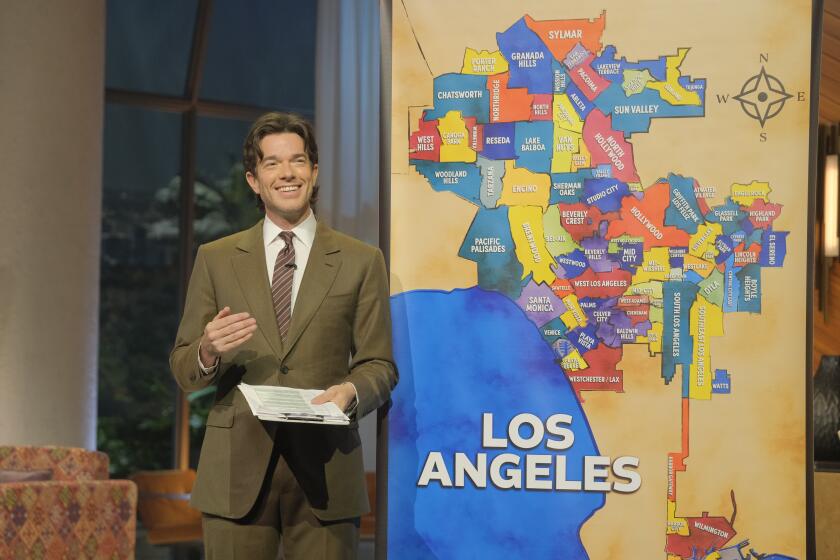The ugliest building in town
- Share via
THE GETTY, City Hall, Union Station. All beautiful structures. Landmarks of L.A., revered by architecture students and chronicled in glossy coffee table books.
Thanks, but we’re not interested. For us, the real California gold is in the structures that send shivers down the spine and elicit commentary such as “craptastic” and “stucco-riffic.”
We recently held a monthlong contest on our blog (Curbed LA, a local architecture and urban planning site) in which we asked readers to name the worst of Los Angeles design and architecture. Our rules were simple: Submit buildings that fall within L.A. city limits and are at least two stories (to avoid submissions of the ubiquitous neighborhood minimall). To discourage people from just walking outside and snapping a photo of their neighbor’s Caliterranean McMansion, single-family homes also were banned.
From the outset, readers had questions about the contest.
“Is Staples Center one ugly building, or several?”
“What if we just take an aerial photo of the Valley?”
“Does ‘Anything by Gehry’ count as one entry?” one reader asked.
Our first official entry came from Echo Park. It was a nondescript apartment building on Sunset, with no vegetation and cinder-block walls. “With its high outdoor stairs and walkways, it always reminded me of an Escher drawing, but in a bad way,” wrote our reader.
As more submissions came in, themes started to emerge. Flat-roofed, stucco box designs. Cheap facades and bad paint jobs. The Beverly Center was universally hated. Our readers used words such as “abomination,” “puke” and “shudder” when submitting entries.
Nominations ran the gamut, from the ‘80s-style corporate glass towers — exemplified by the Directors Guild of America building on Sunset Boulevard, which was likened to a “Costa Mesa bank building” — to a residential building on Mariposa Avenue in Koreatown called “The K-Town Box,” which was vilified for its flat roof and sooty gray facade. The downtown Macy’s was lauded for its “early penitentiary style.” The modernist chicken bucket housing the KFC on Western Avenue was deemed “a strange clown building.”
The contest inspired Whitman-esque poetry. The paint job on the Eagle Rock Public Storage Building “shimmers like fresh vomit,” wrote one reader. “One of the ugliest stucco turds ever to grace a city block” sang a reader who nominated a condo building on Pico Boulevard.
Our four judges, local celebrities in the writing, blogging and architecture worlds (including The Times’ architecture critic), picked the winners.
The bronze went to 5800 Wilshire Blvd., a sterile-looking, two-story glass and marble structure across from the La Brea Tar Pits. The silver went to the Los Angeles Times building at 1st and Spring. Architect Gordon Kaufmann may have won a gold medal at the 1937 Paris Exposition, but his design was “destroyed in the early ‘70s by a very tacked-on renovation,” wrote the submitter.
In the end, our winner prevailed by just one vote. The prize for the ugliest building went to Hollywood & Highland, the much-maligned tourist trap at one of L.A.’s busiest intersections.
Several things helped lift Hollywood & Highland above the other nominations: the tacky reliefs, the obnoxious advertisements, the dark, scary corners. And there are the white elephants: a humorous but unintended reminder of how the mall has struggled financially since opening in 2001.
Wrote one judge in his summation: “Hollywood & Highland personifies everything that we love and hate about Los Angeles: Tackiness. Egregious excess. Hubris. Tourism. Crassness. Vegas-sized lunacy. Japanese pastries. Inappropriate at all levels, but that’s also why we can’t get enough of it. Los Angeles to a ‘T.’ ”
Perhaps Hollywood & Highland’s most egregious sin is that the mall turns its back on the street, creating a pedestrian dead zone along Highland Avenue, a disjointed landscape where neighboring buildings and their occupants fail to interact.
Let it be a warning. As projects such as Grand Avenue, Americana at Brand and the Shops at Santa Anita move forward, we can only hope that street life is included, not destroyed. We really don’t need any more white elephants.
More to Read
The biggest entertainment stories
Get our big stories about Hollywood, film, television, music, arts, culture and more right in your inbox as soon as they publish.
You may occasionally receive promotional content from the Los Angeles Times.











